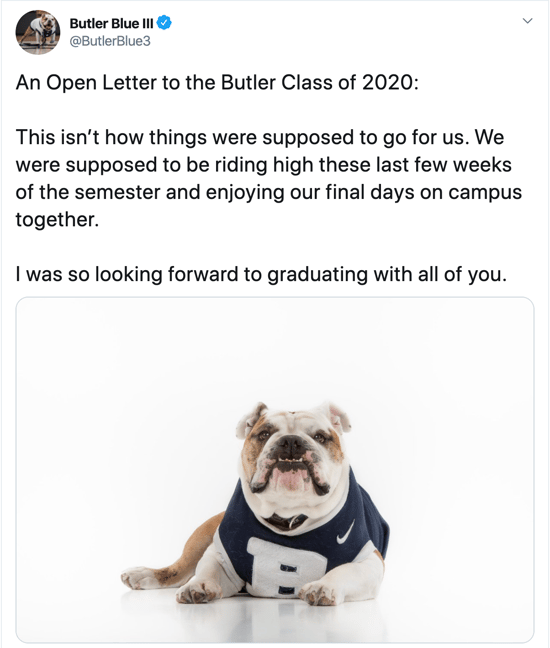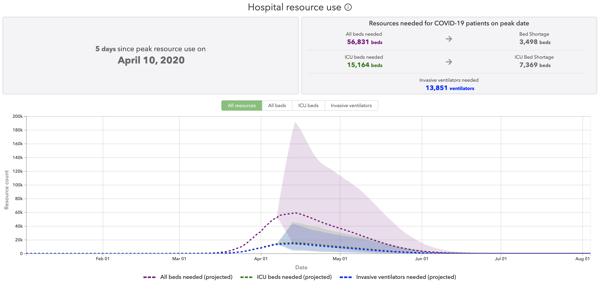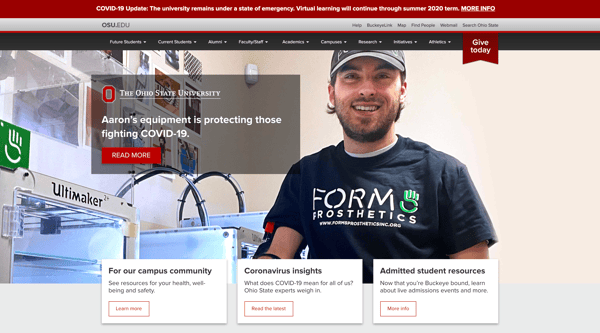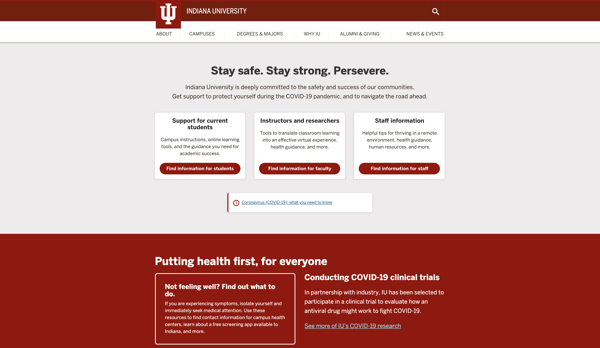Though common long long before COVID-19 began, here's to the heroes has become the rallying cry as brands search for the right tone in which to connect their voices with the global pandemic. No doubt there are plenty of heroes to be celebrated—medical and healthcare professionals, safety and emergency personnel, grocery store workers, and those that are keeping deliveries arriving, and the takeout coming. To say nothing of the government workers processing unemployment claims and countless others across the country.
But there are campus heroes, too, who—especially in times like these—log long hours, own the institution’s voice, and are leaned on for sage advice. And it’s time they are cheered as well.
So here’s to the higher ed marketing communications professionals.
When times are tough and schools or institutional leaders face challenges, the higher ed marketer is there. This has long been the case, whether it’s a natural disaster, reputational risk, someone did something salacious or just downright stupid, or there was a failure of leadership. COVID-19 has required the immediate issues management and response related to evacuating campus; canceling or postponing commencement; deciding whether to refund tuition, housing, and dining dollars; and now budget decisions that will impact real jobs. But as the pandemic stretches on without a clear finish line in sight, this becomes a different issue. And strategic higher ed marketers or communications professionals are taking center stage.
Our heroes (also clients and friends) tend to be focusing on (or being pulled towards, depending on your mood) a few significant areas:
Voice of the Institution
Marketing communications professionals are spending their time updating internal communities on the ways in which the institution is making decisions and dealing with the crisis firsthand. This includes a myriad of internal communications, including video addresses from leadership, ghostwriting letters to the community, listening and responding on social media, and much, much more. Sometimes this means encouraging leaders to share an authentic, heartfelt message as UVA President Jim Ryan did magnificently.Other times it’s reminding your stakeholders what makes your campus special.
And, finally, at times it’s identifying the right messenger to carry the message, as retiring
mascot Butler Blue III did in sharing this message with graduating seniors.  The internal communication demands are never-ending, and often highly scrutinized. But our heroes continue to deliver.
The internal communication demands are never-ending, and often highly scrutinized. But our heroes continue to deliver.
Chief Curator and Storyteller
Regardless of the size of an institution; finding, curating and breaking down silos to get the stories from across a campus is always a challenge. But, again, here’s the marketing communications hero surfacing and sharing tremendous stories of the amazing ways in which faculty, staff, students, and alumni are contributing to fighting this pandemic. Per Campus Sonar’s fabulous COVID-19 briefings, The University of Washington and Johns Hopkins have dominated share of voice. UW’s IMHE models of disease spread and needs for hospitals and PPE equipment, and Johns Hopkins’ COVID-19 dashboard, are constantly cited in media coverage. But both schools have also done a terrific job of storytelling about their direct impacts. 
Schools are also pulling out all the stops to support their students and their communities by gathering resources and making it easy for people to get the information they need to care for themselves or a loved one, or to ease them into their new learning and working environment as events and classes are moved online. This is not an easy task, as content is produced across the institution and typically delivered by various areas for specific audiences (i.e., student affairs for current students). 
You can see some inspiring examples in the terrific homepage re-skins at Ohio State and Indiana University, where all of that information has been curated and presented at the top level of the site. It’s naïve to think that anyone feels that times are normal. Both of these sites do a great job of acknowledging a new reality and surfacing relevant content.
Event Producer
At lots of institutions (again, irrespective of school size), sometimes the voice of marketers wasn’t typically as welcomed in events for prospective students - especially admitted student events. But overnight, our heroes have become live event producers and directors, turning ZOOM invites into full-blown productions. They’ve also had ideas on how to turn simple technology into amazing storytelling. Cal Poly’s student ambassadors conducted selfie-stick campus tours, and the marketing team edited them into a heartfelt and personal production.
Hamilton College held a Facebook live drone event where users could steer the drone to see the parts of campus they missed. And a YouTube Live panel session with Kenyon College faculty drew almost 300 active views during an hour-long session with admitted students. They’re now leading efforts to make graduations and commencement experiences virtual.
Beyond individual events and productions, both York College and Drexel have created amazing admitted student experiences full of live and recorded events as well as content, quizzes, fun activities and valuable information.
It seems naïve to assume that in a month, or six months, things will return to normal — that campuses will be bustling, or that miraculously the financial and enrollment impacts of this pandemic will just bounce back. We’re much more likely to wind up in the state that higher education leader Gordon Gee described:
“This is a black swan moment for our country, which requires universities to lead and not follow... we must constantly fix our eyes on the future... because changes to our world will linger after this virus subsides, we must find ways to educate and sustain our university families while operating in a new environment."


%20(1).jpg)









